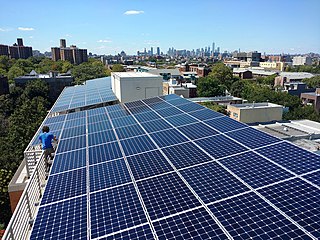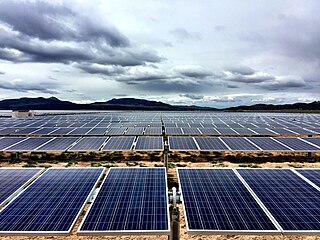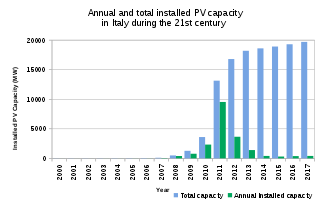
Solar energy is radiant light and heat from the Sun that is harnessed using a range of technologies such as solar power to generate electricity, solar thermal energy, and solar architecture. It is an essential source of renewable energy, and its technologies are broadly characterized as either passive solar or active solar depending on how they capture and distribute solar energy or convert it into solar power. Active solar techniques include the use of photovoltaic systems, concentrated solar power, and solar water heating to harness the energy. Passive solar techniques include orienting a building to the Sun, selecting materials with favorable thermal mass or light-dispersing properties, and designing spaces that naturally circulate air.

Solar Energy Generating Systems (SEGS) is a concentrated solar power plant in California, United States. With the combined capacity from three separate locations at 354 megawatt (MW), it was once the world's second largest solar thermal energy generating facility, until the commissioning of the even larger Ivanpah facility in 2014. It consisted of nine solar power plants in California's Mojave Desert, where insolation is among the best available in the United States.

Many countries and territories have installed significant solar power capacity into their electrical grids to supplement or provide an alternative to conventional energy sources. Solar power plants use one of two technologies:

There are several solar power plants in the Mojave Desert which supply power to the electricity grid. Insolation in the Mojave Desert is among the best available in the United States, and some significant population centers are located in the area. These plants can generally be built in a few years because solar plants are built almost entirely with modular, readily available materials. Solar Energy Generating Systems (SEGS) is the name given to nine solar power plants in the Mojave Desert which were built in the 1980s, the first commercial solar plant. These plants have a combined capacity of 354 megawatts (MW) which made them the largest solar power installation in the world, until Ivanpah Solar Power Facility was finished in 2014.

Spain is one of the first countries to deploy large-scale solar photovoltaics, and is the world leader in concentrated solar power (CSP) production.

Solar power represented a very small part of electricity production in the United Kingdom until the 2010s when it increased rapidly, thanks to feed-in tariff (FIT) subsidies and the falling cost of photovoltaic (PV) panels.

Solar power is the conversion of energy from sunlight into electricity, either directly using photovoltaics (PV) or indirectly using concentrated solar power. Photovoltaic cells convert light into an electric current using the photovoltaic effect. Concentrated solar power systems use lenses or mirrors and solar tracking systems to focus a large area of sunlight to a hot spot, often to drive a steam turbine.

Solar power includes solar farms as well as local distributed generation, mostly on rooftops and increasingly from community solar arrays. In 2021, utility-scale solar power generated 115 terawatt-hours (TWh), or 2.8% of electricity in the United States. Total solar generation that year, including estimated small-scale photovoltaic generation, was 164 TWh.
A photovoltaic system, also PV system or solar power system, is an electric power system designed to supply usable solar power by means of photovoltaics. It consists of an arrangement of several components, including solar panels to absorb and convert sunlight into electricity, a solar inverter to convert the output from direct to alternating current, as well as mounting, cabling, and other electrical accessories to set up a working system. It may also use a solar tracking system to improve the system's overall performance and include an integrated battery.
The nominal power is the nameplate capacity of photovoltaic (PV) devices, such as solar cells, modules and systems, and is determined by measuring the electric current and voltage in a circuit, while varying the resistance under precisely defined conditions. The nominal power is important for designing an installation in order to correctly dimension its cabling and converters.

The use of solar energy began in Israel in the 1950s with the development by Levi Yissar of a solar water heater to address the energy shortages that plagued the new country. By 1967 around 5% of water of households were solar heated and 50,000 solar heaters had been sold. With the 1970s oil crisis, Harry Zvi Tabor developed the prototype of the solar water heater now used in over 90% of Israeli homes. There are over 1.3 million solar water heaters installed as a result of mandatory solar water heating regulations.

Solar power has been growing rapidly in the U.S. state of California because of high insolation, community support, declining solar costs, and a renewable portfolio standard which requires that 60% of California's electricity come from renewable resources by 2030, with 100% by 2045. Much of this is expected to come from solar power via photovoltaic facilities or concentrated solar power facilities.

Solar power in Arizona has the potential to, according to then-Governor Janet Napolitano, make Arizona "the Persian Gulf of solar energy". In 2012, Arizona had 1,106 MW of photovoltaic (PV) solar power systems, and 6 MW of concentrated solar power (CSP), bringing the total to over 1,112 megawatts (MW) of solar power. As an example, the Solana Generating Station, a 280 MW parabolic trough solar plant, when commissioned in 2013, was the largest parabolic trough plant in the world and the first U.S. solar plant with molten salt thermal energy storage.

The Ashalim power station is a concentrated solar power station in the Negev desert near the kibbutz of Ashalim, south of the district city of Be'er Sheva in Israel. It consists of three plots with three different technologies the station combines 3 kinds of energy: solar thermal energy, photovoltaic energy, and natural gas.
Bombard Renewable Energy is an American provider of renewable energy services located in Nevada at Las Vegas. Bombard's primary services include the design, financing, construction, installation, operations, and maintenance of solar photovoltaic ("PV") energy systems. Additionally, Bombard performs energy efficiency audits, designs, and constructs mobile solar PV charging stations. Bombard specializes in building solar power systems that use solar photovoltaic (PV), wind energy and concentrated PV, also known as CSPV.

Natural Bridges National Monument Solar Power System is an experimental electrical power plant at the Natural Bridges National Monument in the southeastern portion of the U.S. state of Utah. It consists of 256,812 solar cells arranged in 12 rows, each measuring 200 feet (61 m) long. Direct current energy from the array is converted to alternating current at an equipment building, then supplied to the park's staff buildings and visitor center. Excess energy is stored in a bank of batteries that is used on cloudy days. The system is controlled by computers and creates fewer emissions than the diesel generators that it replaced.
Amonix, Inc. is a solar power system developer based in Seal Beach, California. The company manufactures concentrator photovoltaic (CPV) products designed for installation in sunny and dry climates. CPV products convert sunlight into electrical energy in the same way that conventional solar photovoltaic technology does, except that they use optics to focus the solar radiation before the light is absorbed by solar cells. According to a comparative study of energy production of solar technologies, CPV systems require no water for energy production and produce more energy per megawatt (MW) installed than traditional PV systems. Amonix has nearly 70 megawatts of CPV solar power systems deployed globally, including Southwestern U.S. and Spain. In May 2012, the Alamosa Solar Generating project, owned and operated by Cogentrix Energy, began commercial operation. This is the largest CPV power plant in the world and is expected to produce enough clean renewable energy per year to power more than 6,500 homes and will avoid the emissions of over 43,000 metric tons of carbon dioxide per year. The Alamosa Solar Generating Project is supported by a power purchase agreement (PPA), which is a long-term agreement to sell the power it will generate. Under the project's PPA, the Public Service Company of Colorado will buy the power generated by the solar facility for the next 20 years. In July 2012, Amonix set the world record for photovoltaic module efficiency at 33.5% under nominal operating conditions, verified by the National Renewable Energy Laboratory. In April 2013, Amonix broke the record set in July 2012, demonstrating photovoltaic module efficiency at 34.9% under normal concentrator standard operating conditions, also verified by the National Renewable Energy Laboratory. In August 2013, Amonix announced it had achieved a 35.9% photovoltaic module efficiency rating under concentrator standard test conditions (CSTC) as calculated by NREL. In June, 2014, the assets of Amonix were acquired by Arzon Solar, LLC for the purpose of continued development of CPV technology and products.

Solar power is an important contributor to electricity generation in Italy, accounting for 8% of the total in 2017. As of 2022, the country has a total installed capacity of 22.56 GW. In 2019, Italy set a national goal of reaching 50 GW by 2030.
Solar energy – radiant light and heat from the sun. It has been harnessed by humans since ancient times using a range of ever-evolving technologies. Solar energy technologies include solar heating, solar photovoltaics, solar thermal electricity and solar architecture, which can make considerable contributions to solving some of the most urgent problems that the world now faces.
There are many practical applications for solar panels or photovoltaics. From the fields of the agricultural industry as a power source for irrigation to its usage in remote health care facilities to refrigerate medical supplies. Other applications include power generation at various scales and attempts to integrate them into homes and public infrastructure. PV modules are used in photovoltaic systems and include a large variety of electrical devices.














